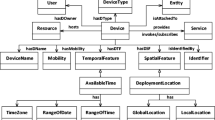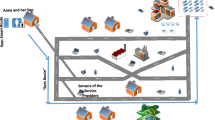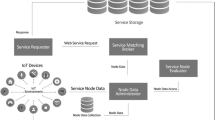Abstract
The Internet of Things (IoT) vision involves a future Internet integrated with real-world objects that can commonly offer their functionality trough services. In such pervasive environments of IoT networks, locating and invoking suitable services is quite challenging and traditional service discovery and selection approaches have been proven inadequate. In this paper, taking inspiration from natural metaphors, a decentralized service discovery and selection model is proposed. The model is based on artificial potential fields (APFs) which are formed upon each user service request and become active at points where services can be provided. Such points are termed as service provision nodes (SPNs). The strength of each APF depends on the percentage of requested services that can be provided by the respective SPN, as well as on SPN service load and availability with the aim to balance service load among SPNs. Service discovery and selection is then driven by artificial forces applied among user service requests and SPNs. Simulation results indicate that the proposed approach maintains satisfactory performance and scalability as the number of SPNs in an IoT network increase and efficient load balancing of the requested services among the SPNs in comparison with other approaches.








Similar content being viewed by others
References
Zambonelli F, Viroli M (2011) A survey on nature-inspired metaphors for pervasive service ecosystems. Int J Pervasive Comput Commun 7(3):186–204
Christin D, Reinhardt A, Mogre PS, Steinmetz R (2009) Wireless sensor networks and the internet of things: selected challenges. In: Proceedings of the 8th GI/ITG KuVS Fachgespräch Drahtlose sensornetze, pp 31–34
Teixeira T, Hachem S, Issarny V, Georgantas N (2011) Service oriented middleware for the internet of things: a perspective. In: Abramowicz W, Llorente I, Surridge M, Zisman A, Vayssiere J (eds) Towards a service-based internet. Springer, Berlin, Heidelberg, pp 220–229
Ma HD (2011) Internet of things: objectives and scientific challenges. J Comput Sci Technol 26(6):919–924
Atzori L, Iera A, Morabito G (2010) The internet of things: a survey. Comput Netw 54(15):2787–2805
Uckelmann D, Harrison M, Michahelles F (2011) An architectural approach towards the future internet of things. Springer, Berlin
Ahmed T, Tripathi A, Srivastava A (2014) Rain4service: an approach towards decentralized web service composition. In: 2014 IEEE international conference on services computing (SCC). IEEE, pp 267–274
Spiess P, Karnouskos S, Guinard D, Savio D, Baecker O, De Souza LMS, Trifa V (2009) Soa-based integration of the internet of things in enterprise services. In: IEEE international conference on web services, 2009. ICWS 2009. IEEE, pp 968–975
Csorba MJ, Meling H, Heegaard PE (2011) A bio-inspired method for distributed deployment of services. New Gener Comput 29(2):185–222
Chan NN, Gaaloul W, Tata S (2012) A recommender system based on historical usage data for web service discovery. SOCA 6(1):51–63
Chen H, Li S (2010) Src: a service registry on cloud providing behavior-aware and qos-aware service discovery. In: 2010 IEEE international conference on service-oriented computing and applications (SOCA). IEEE, pp 1–4
Clement L, Hately A, von Riegen C, Rogers T et al (2004) Uddi version 3.0. 2, uddi spec technical committee draft. OASIS open standards consortium
Papadopoulos P, Tianfield H, Moffat D, Barrie P (2013) Decentralized multi-agent service composition. Multiagent Grid Syst 9(1):45–100
Al-Masri E, Mahmoud QH (2006) A context-aware mobile service discovery and selection mechanism using artificial neural networks. In: Proceedings of the 8th international conference on electronic commerce: the new e-commerce: innovations for conquering current barriers, obstacles and limitations to conducting successful business on the internet. ACM, pp 594–598
Guinard D, Trifa V, Karnouskos S, Spiess P, Savio D (2010) Interacting with the soa-based internet of things: discovery, query, selection, and on-demand provisioning of web services. IEEE Trans Serv Comput 3(3):223–235
He Q, Yan J, Yang Y, Kowalczyk R, Jin H (2013) A decentralized service discovery approach on peer-to-peer networks. IEEE Trans Serv Comput 6(1):64–75
Sapkota B, Roman D, Kruk SR, Fensel D (2006) Distributed web service discovery architecture. In: Null. IEEE, p 136
Li Y, Zou F, Wu Z, Ma F (2004) Pwsd: a scalable web service discovery architecture based on peer-to-peer overlay network. In: Jeffrey Xu Yu, Xuemin Lin, Hongjun Lu, Yanchun Zhang (eds) Advanced web technologies and applications. Springer, Berlin, Heidelberg, pp 291–300
He Q, Yan J, Yang Y, Kowalczyk R, Jin H (2008) Chord4s: a p2p-based decentralised service discovery approach. In: IEEE international conference on services computing, 2008. SCC’08, vol 1. IEEE, pp 221–228
Bicchi A, Marigo A, Pappas G, Pardini M, Parlangeli G, Tomlin C, Sastry S (1998) Decentralized airtraffic management systems: performance and fault tolerance. In: Proceedings of IFAC international workshop on motion control, Grenoble. Citeseer, pp 279–284
Stoica I, Morris R, Karger D, Kaashoek MF, Balakrishnan H (2001) Chord: a scalable peer-to-peer lookup service for internet applications. ACM SIGCOMM Comput Commun Rev 31(4):149–160
Gharzouli M, Boufaida M (2011) Pm4sws: a p2p model for semantic web services discovery and composition. J Adv Inf Technol 2(1):15–26
Ahmed T, Mrissa M, Srivastava A (2014) Magel: a magneto-electric effect-inspired approach for web service composition. In: 2014 IEEE international conference on web services (ICWS). IEEE, pp 455–462
Mamei M, Zambonelli F (2006) Field-based coordination for pervasive multiagent systems. Springer Science & Business Media, Berlin
Lenders V, May M, Plattner B (2005) Service discovery in mobile ad hoc networks: a field theoretic approach. Pervasive Mobile Comput 1(3):343–370
Adeli H, Tabrizi MHN, Mazloomian A, Hajipour E, Jahed M (2011) Path planning for mobile robots using iterative artificial potential field method. Int J Comput Sci Issues 8(4):28–32
Jaradat MAK, Garibeh MH, Feilat EA (2012) Autonomous mobile robot dynamic motion planning using hybrid fuzzy potential field. Soft Comput 16(1):153–164
Masoud AA (2007) Decentralized self-organizing potential field-based control for individually motivated mobile agents in a cluttered environment: a vector-harmonic potential field approach. IEEE Trans Syst Man Cybern Part A: Syst Hum 37(3):372–390
Jiang HF, Qian JS, Sun YJ (2011) Virtual electrostatic field based multi-sink routing algorithm in WSN. J China Univ Min Technol 40(2):321–326
Xu YS, Ren FY (2009) Potential field based multi-strategy routing protocol in WSN. ZTE Commun 15(6):32–36
Jiang H, Sun Y, Sun R, Chen W, Ma S, Gao J (2014) A distributed energy optimized routing using virtual potential field in wireless sensor networks. Int J Distrib Sens Netw 2014:10
Kalantari M, Shayman M (2006) Design optimization of multi-sink sensor networks by analogy to electrostatic theory. In: IEEE wireless communications and networking conference, 2006. WCNC 2006, vol 1. IEEE, pp 431–438
Ruchti J, Senkbeil R, Carroll J, Dickinson J, Holt J, Biaz S (2011) Uav collision avoidance using artificial potential fields. Tech. rep. CSSE11-03, Computer Science and Software Engineering Department, Auburn University
Rapti E, Karageorgos A, Gerogiannis VC (2015) Decentralised service composition using potential fields in internet of things applications. Proc Comput Sci 52:700–706
Gu X, Nahrstedt K, Yu B (2004) Spidernet: an integrated peer-to-peer service composition framework. In: 2004. Proceedings 13th IEEE international symposium on high performance distributed computing. IEEE, pp 110–119
Chakraborty D, Perich F, Joshi A, Finin T, Yesha Y (2003) A reactive service composition architecture for pervasive computing environments. In: Cambyse GO (ed) Mobile and wireless communications. Springer, Berlin, Heidelberg, pp 53–60
Yu T, Zhang Y, Lin K-J (2007) Efficient algorithms for web services selection with end-to-end qos constraints. ACM Trans Web (TWEB) 1(1):6
Luo J-Z, Zhou J-Y, Wu Z-A (2009) An adaptive algorithm for qos-aware service composition in grid environments. SOCA 3(3):217–226
Al-Oqily I, Karmouch A (2011) A decentralized self-organizing service composition for autonomic entities. ACM Trans Auton Adapt Syst (TAAS) 6(1):7
Sun microsystems, jini architecture specification version 2.0 (2003). http://www.sun.com/software/jini/specs/
Waldo J (1998) Javaspaces specification 1.0. Sun Microsyst 29 Technical report, p 30
Universal Plug (2003) Play (upnp) forum. Microsoft Corporation
Veizades J, Guttman E, Perkins CE, Kaplan S (1997) Service location protocol. Internet Eng Task Force: RFC 2165, p 72. https://www.ietf.org/rfc/rfc2165.txt
Czerwinski SE, Zhao BY, Hodes TD, Joseph AD, Katz RH (1999) An architecture for a secure service discovery service. In: Proceedings of the 5th annual ACM/IEEE international conference on mobile computing and networking. ACM, pp 24–35
Ratnasamy S, Francis P, Handley M, Karp R, Shenker S (2001) A scalable content-addressable network, vol 31. ACM, New York
Rowstron A, Druschel P (2001) Pastry: scalable, decentralized object location, and routing for large-scale peer-to-peer systems. In: Rachid G (ed) Middleware 2001. Springer, Berlin, Heidelberg, pp 329–350
Khatib O (1986) Real-time obstacle avoidance for manipulators and mobile robots. Int J Robot Res 5(1):90–98
Kim DH, Wang H, Shin S (2006) Decentralized control of autonomous swarm systems using artificial potential functions: analytical design guidelines. J Intell Rob Syst 45(4):369–394
Vallée M, Ramparany F, Vercouter L (2005) A multi-agent system for dynamic service composition in ambient intelligence environments. Citeseer, Grenoble
Puliafito A, Cucinotta A, Minnolo AL, Zaia A (2010) Making the internet of things a reality: the wherex solution. In: Daniel G, Antonio I, Giacomo M, Luigi A (eds) The internet of things. Springer, New York, pp 99–108
Luke S, Cioffi-Revilla C, Panait L, Sullivan K, Balan G (2005) Mason: a multiagent simulation environment. Simulation 81(7):517–527
Acknowledgments
This research has been supported by GSRT (General Secretariat for Research and Technology), Program: “National Strategic Reference Framework 2007–13”, Act: “Support for SMEs Groups for Research and Technological Development”, Project title: “e-Furniture: Dynamic Networking of Furniture and Wood Product Manufacturing Enterprises”.
Author information
Authors and Affiliations
Corresponding author
Rights and permissions
About this article
Cite this article
Rapti, E., Karageorgos, A., Houstis, C. et al. Decentralized service discovery and selection in Internet of Things applications based on artificial potential fields. SOCA 11, 75–86 (2017). https://doi.org/10.1007/s11761-016-0198-1
Received:
Revised:
Accepted:
Published:
Issue Date:
DOI: https://doi.org/10.1007/s11761-016-0198-1




